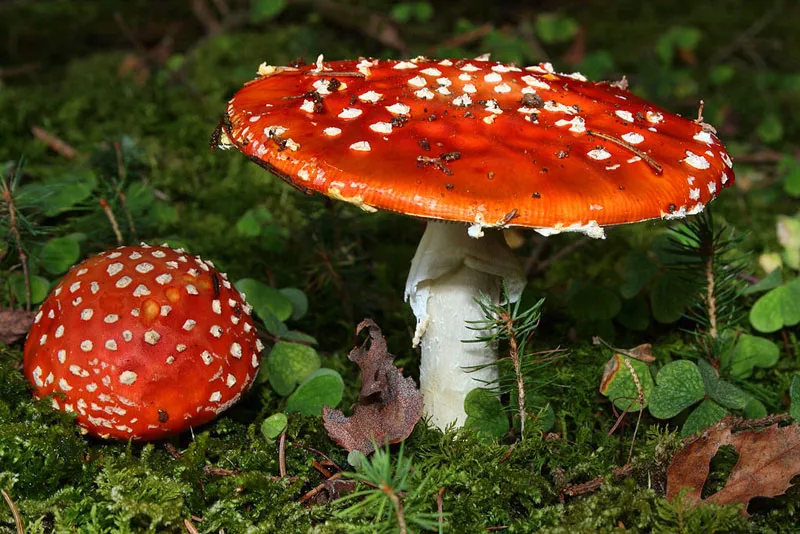Deadly Mushrooms Around the World: A Traveler’s Guide to Nature’s Most Lethal Fungi
While foraging for wild mushrooms can be an exciting adventure, some species are dangerously toxic. Consuming certain mushrooms, such as the Angel Wing or Autumn Skullcap, can lead to severe liver, kidney, and nervous system damage—often resulting in fatal consequences. Before you embark on a foraging journey, it's crucial to know which fungi to avoid at all costs.
Top 12 Deadliest Mushrooms on Earth
- Fly Agaric (Amanita muscaria)
- Angel Wing (Pleurocybella porrigens)
- Deadly Dapperling (Lepiota spp.)
- Podostroma Cornu-damae
- Conocybe Filaris
- Webcap (Cortinarius rubellus)
- Autumn Skullcap (Galerina marginata)
- False Morel (Gyromitra esculenta)
- Destroying Angel (Amanita spp.)
- Death Cap (Amanita phalloides)
- Inky Cap (Coprinus atramentarius)
- Ergot Fungus (Claviceps purpurea)
A Closer Look at These Lethal Fungi
1. Fly Agaric (Amanita muscaria)
A fairytale-like mushroom with a bright red cap speckled with white spots, the Fly Agaric is both visually enchanting and highly toxic. If ingested, it can cause nausea, hallucinations, drowsiness, and even death in severe cases. Its primary toxins, muscimol and ibotenic acid, affect the central nervous system, leading to altered perception and intense discomfort.

2. Angel Wing (Pleurocybella porrigens)
Commonly found in the Northern Hemisphere, the Angel Wing mushroom was once considered edible. However, a tragic event in 2004 led to nearly 60 poisonings in Japan, with 17 fatalities occurring within six weeks. Scientists have yet to fully understand its toxic compounds, though research suggests it may contain high levels of cyanide and amino acids that destroy brain cells.

3. Deadly Dapperling (Lepiota spp.)
This seemingly harmless mushroom grows in pine forests across Europe and North America but harbors amatoxins—substances responsible for 80-90% of mushroom poisoning fatalities. Without treatment, the mortality rate is nearly 50%. Initial symptoms include abdominal pain and digestive distress, followed by irreversible liver failure.

4. Podostroma Cornu-damae
Resembling a hand reaching from the ground, Podostroma Cornu-damae contains trichothecene mycotoxins, which cause severe skin peeling, hair loss, and fatal organ damage. Victims often experience symptoms similar to radiation poisoning, with massive blood cell depletion and neurological distress.

5. Conocybe Filaris
A common sight in grassy fields of the Pacific Northwest, Conocybe Filaris looks harmless but is highly poisonous. Packed with amatoxins, this mushroom causes irreversible liver damage. Unfortunately, symptoms may take hours to appear, leading victims to believe they are safe until it is too late.

6. Webcap (Cortinarius rubellus)
A single bite of this deadly fungus can cause lifelong kidney failure. Webcap contains orellanine, a toxin with no known antidote. Survivors often require dialysis or kidney transplants to stay alive.

7. Autumn Skullcap (Galerina marginata)
This small brown mushroom grows worldwide on decaying wood, mimicking edible species. However, its amatoxin content makes it one of the most dangerous fungi. Liver failure and an agonizing death await those who mistake it for a safe variety.

8. False Morel (Gyromitra esculenta)
While some Scandinavian and Eastern European cultures consider False Morel a delicacy, it must be meticulously prepared to remove its deadly gyromitrin toxin. Consumed raw, it leads to violent convulsions, dizziness, and organ failure. Even cooked, residual toxins can accumulate in the body over time.

9. Destroying Angel (Amanita spp.)
With its elegant white appearance, the Destroying Angel hides a sinister secret: it contains lethal amatoxins. Symptoms—cramping, delirium, seizures, and organ failure—appear within hours. Without a liver transplant, death is nearly inevitable.

10. Death Cap (Amanita phalloides)
Death Cap is responsible for most accidental mushroom poisoning deaths worldwide. A single mushroom can kill an adult, as its amatoxin content remains lethal even when cooked, dried, or frozen. Historical figures such as Roman Emperor Claudius are believed to have perished after consuming this deadly fungus.

11. Inky Cap (Coprinus atramentarius)
By itself, the Inky Cap is not harmful, but when combined with alcohol, it triggers toxic reactions. The mushroom’s compounds interfere with alcohol metabolism, leading to facial flushing, nausea, and extreme discomfort.

12. Ergot Fungus (Claviceps purpurea)
Growing on rye and other cereal grains, Ergot Fungus produces alkaloids that cause convulsions, hallucinations, and gangrene. Historically, ergot poisoning—also called St. Anthony’s Fire—led to mass outbreaks of sickness in medieval Europe. While low doses are used in medicine, high exposure is lethal.

Final Travel Tip: Look, But Don’t Touch!
Foraging for wild mushrooms can be a thrilling experience, but it comes with risks. If you’re unsure about a mushroom’s identity, it’s best to admire it from a distance rather than take a deadly chance. Whether you’re hiking through the lush forests of North America or exploring the misty landscapes of Europe, be aware of these toxic fungi to ensure a safe and unforgettable adventure!
